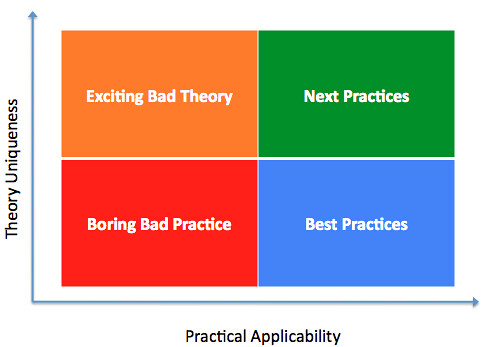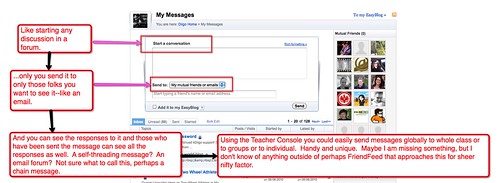

I love finding useful, thought-provoking and oddly congruent ideas from other disciplines. I have thoroughly enjoyed reading Wikibon lately and this post's graph is a good example. I have always railed against the notion of a generalized 'best practice' because it is so contrary to complex and diverse systems like classrooms. You may have your own best practice, but only if it is customized to you. But I do like the idea of 'next practice' . We should be wandering about inside and outside our disciplines foraging for not just the new new thang, but the idea or practice that is both practical and unique. In other words it must be both do-able as well as be appealingly fresh to our brains. If it is practical then we won't reject it out of hand and if it is unique, then it sets off all kinds of interesting and happy chemical cascades in our brains.
I use my social bookmarking tools, Diigo especially, to find these handy and 'deviant' tools. (Deviant in the statistical sense of standard deviance.) Here are a couple of qualifying samples of the unique and practical.
Productivity guru, Mark Forster, has developed a method for getting stuff done that he calls Autofocus . I am considering giving this tool a whirl, but the little piece of deviance I have found is in a reference to an animation created by Andreas Hoffman that demonstrates how the technique is done. When you click on the 'animation' you download a pdf. When I first opened it I thought Forster had the link wrong, but then you notice that the pdf has over 600 pages. Hoffman has used each pdf page like an animation cell. This is certainly a deviant use for pdf, but one that is unique and practical. Are there other uses for this 'animation style'? Could I combine this pdf with a screencast? Acrobat has an automatic scroll function so you could start your screencast and then autoscroll. I am sure others can come up with something sweeter and better with a little thought, but this a prime example of a deviant use that is completely handy.
Another example is the messaging/threading function I have just discovered in Diigo. Below is a screenshot from my account with annotations:

Like I wrote in my annotation, I don't use anything like this anywhere in my toolkit. I think it is very practical for the classroom in light of the very safe, secure, and social "Teacher Console" within Diigo for K-12. In higher ed it encourages social connection inside and out of the classroom as well as legitimizing right click research for students. This is the first tool I teach my students each semester and with this new messaging system, it, like the rug in "The Big Lebowski", really ties the 'room' together, dude.
Last, I am always looking for new presentation tools and styles for my students. I have adopted the pecha kucha for the last couple of years for its sheer fun and effectiveness. Students love it, too. Although this style doesn't lend itself to improvisation (which I am very attracted to in my own teaching) I have recently discovered a way to combine two familiar tools into one that could be instructive and fun in the classroom. It is called "Battledecks" and can best be described as powerpoint karaoke. Below is a rather profane video of Anil Dash putting battledecks through its paces.
Will I use this in my composition class this year? It is fondly to be hoped. Perhaps after we research a particular topic and write a paper I will put together a battledeck or two or ten based on that topic and see where my students take it. This means that I will have to practice battledecking myself. I find that tools owned are tools shared.
My larger point here is that we need to have our internal radar up as we free range for new stuff to integrate into our classrooms. All you need to do is to stick out those antennae that sense what piques you. It is a capacity we all have, but sometimes we don't allow it to come out and play. The affordances it offers are staggering. You never know what glorious fun will come from a spin of that wheel, but I guarantee it will be interesting especially if you offer your students the same opportunity.
No comments:
Post a Comment